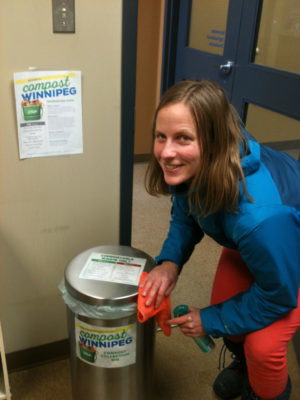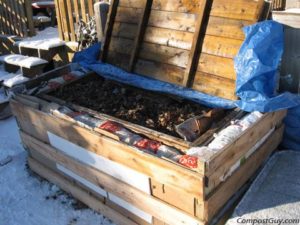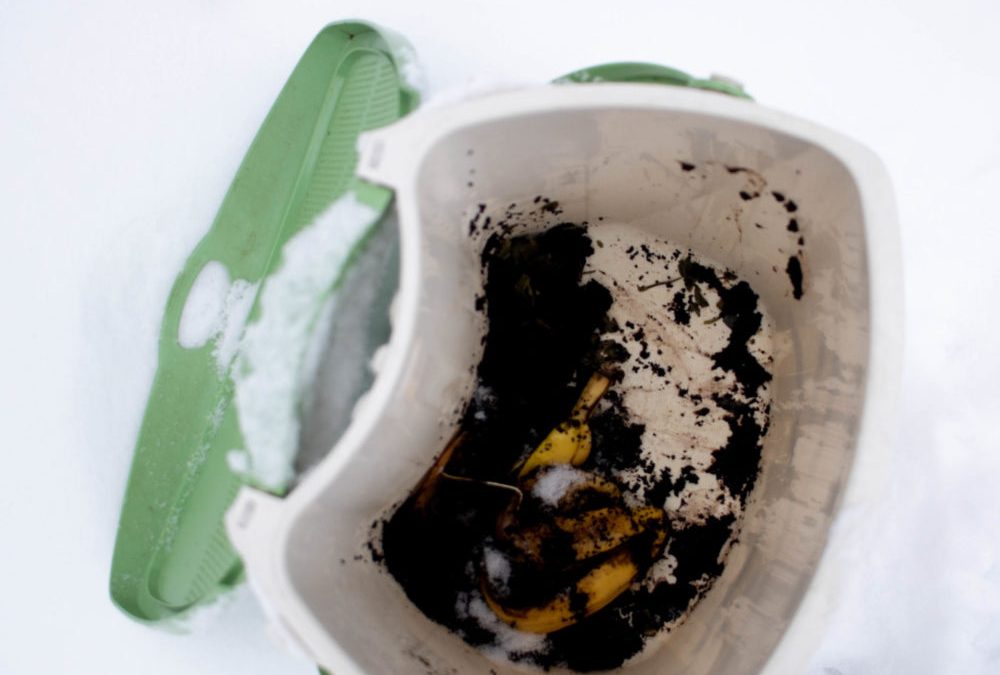Polar vortex or not, winter can be a challenging time to compost. Whether you’re dealing with frozen compost or wading through hip-deep snow to your bin, many Manitobans feel discouraged when it comes to keeping up with the composting year-round. But fear not, this is your demystifying guide to winter composting – yes, even in -30˚C!
Indoor Options
Do cold temperatures send you shivering indoors with a blanket, hot cocoa (or mulled cider), and a big dose of denial until spring? Then vermicomposting or Bokashi composting might be for you!
 Vermicomposting
Vermicomposting
We’ve written a whole guide for you on how to do vermicomposting! This nifty compost method involves a bin (you can purchase one or make one yourself out of two Rubbermaid containers), and some special worms called red wriggler, or Eisinia Fetida. Some shredded paper or coconut coir, dampened, makes a perfect bedding for the worms, which you then feed fruit and vegetable scraps. They can consume approximately half their body weight in food scraps per week, and their population will grow or shrink to accommodate how much you feed them. Check out our PDF booklet or read more on the website.
Bokashi Composting
Bo-who? Bokashi isn’t technically a composting method, but rather a way of fermenting your food scraps to produce pre-compost which will break down quickly in your garden come spring. There’s plenty of online tutorials on how to do this (it’s Green Action Centre’s next composting experiment). The bonus? Unlike vermicomposting, you can include meat and bones because the acidity of the fermenting kills off pathogens. Because you keep it lidded, it keeps for quite a while and doesn’t smell. The downside is that the finished product isn’t actually compost, and there can be some cost to keeping yourself supplied with the Bokashi mix (a mixture of beneficial micro-organisms and bran). Here’s one resource we find helpful for getting started.
Pay Someone Else to Do It For You!
 If you have meat and dairy scraps, if you find compost icky, or hate venturing out into the cold, Compost Winnipeg might be your answer. This social enterprise will take meat, dairy, oils, napkins, bones, and food-soiled paper, on top of your usual fruit and vegetable scraps (you’ll still have to find your own solution for pet waste though). A $15 deposit on the bucket and $35 a month gets you weekly pickups and a clean bin each week so you don’t even have to do the washing! Contact info@compostwinnipeg.ca to see if we’re serving your neighbourhood.
If you have meat and dairy scraps, if you find compost icky, or hate venturing out into the cold, Compost Winnipeg might be your answer. This social enterprise will take meat, dairy, oils, napkins, bones, and food-soiled paper, on top of your usual fruit and vegetable scraps (you’ll still have to find your own solution for pet waste though). A $15 deposit on the bucket and $35 a month gets you weekly pickups and a clean bin each week so you don’t even have to do the washing! Contact info@compostwinnipeg.ca to see if we’re serving your neighbourhood.

Use Somebody Else’s Bin
In a few neighbourhoods, there are community compost bins run by community gardens or community associations. These bins can accept plant-based waste only, so keep the meat, dairy, bones, and oil out! This is a good option if you don’t mind carrying your bin over and if you have a smaller amount of compost to dump – some of the sites can fill up as many people use them through the winter. Want to find the closest one to you? We made a list for you! Let us know if we missed any.

Outdoors at your home: Tips and Tricks
Despite all these options, there’s no reason why you can’t continue using your backyard bin in the winter. We’ve written about this before, with compost team members explaining how to troubleshoot and discussing whether you need to keep adding browns in with the greens (spoiler alert: you don’t need to, but you can if you want). A Master Composter recently showed us how she takes the organics in her kitchen bin and wraps them up in a couple layers of newspaper just like a burrito. Then she
drops the brick into a bucket just outside her back door. That way, she only has to make the trek out to her bin when the bucket fills up, and the dry newspaper bricks transfer neatly from bucket to bin – no fuss, no muss.
Got questions? Comments? Comment below or shoot us an email at compost@greenactioncentre.ca. We also staff our phone InfoLine during office hours at 204-925-3777. No question is too small!




Great tips for working around the winter weather. Making numerous trips to your bin in winter can present an obstacle for some people. In my case my bin is at the very back of a fairly deep lot, so I keep a 5 gallon pail in the garage. I dump the compostables into the pail and when it is full I make a trip to the bin.